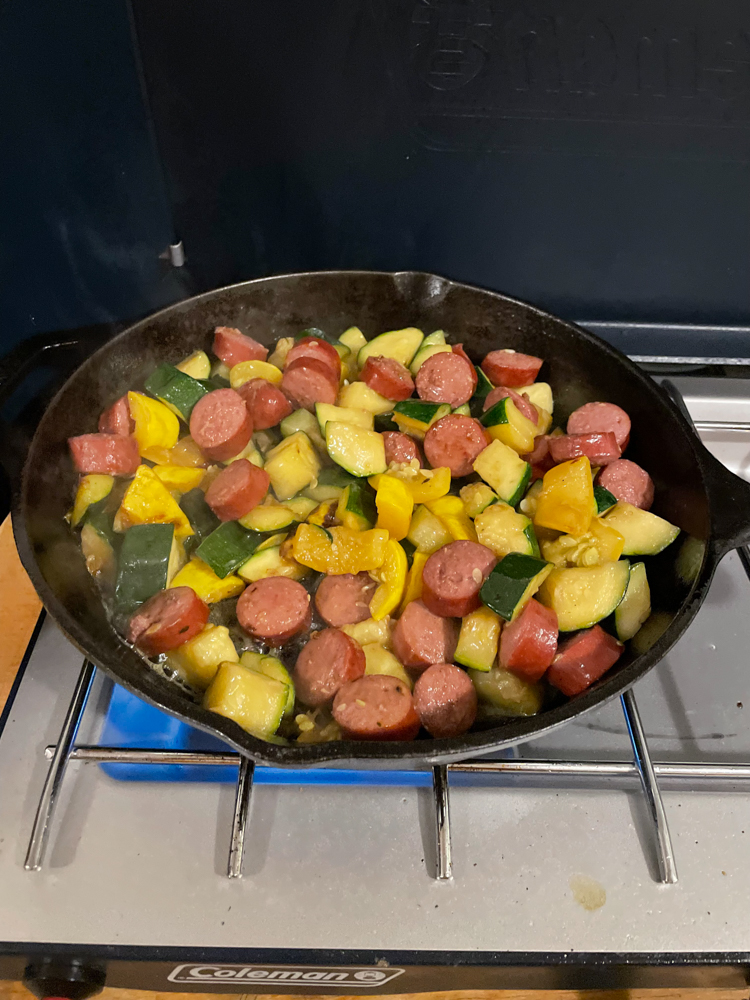A Beginners Guide to Cooking While Camping + Recipes
One of the challenges for a beginner camper is the question, “What am I going to eat when I’m out in nature?” Instead of this being a hinderance to your outdoor experience, instead try thinking of it as a fun and interactive activity with your fellow campers. There are many different ways to cook in the outdoors and it can be fun to get creative and get the whole crew involved. In this article we will discuss different styles of cooking, what tools and equipment you’ll need for each method, and our favorite camp recipes. Grab a snack and join us on a culinary camping adventure.
Ways To Cook Your Meals
Propane Stove
The propane stove is the most straightforward cooking option, but also the most equipment intensive. We recommend something simple such as a 2-burner GSI Outdoor Selkirk Camp Stove or a classic Coleman stove.

For this method of cooking you use a self-contained propane stove (generally found as 1 or 2 burner). As the name suggests, these stoves use propane gas, which come ready to use with 1 lb propane containers (commonly green containers found at any outdoor, hardware, or big box store) or you can use larger propane tanks such as 5 lbs or 20 lbs tanks with a hose converter that is sold separately. In addition to the stove itself, it is helpful to have a table on which to put your stove such as this Big Agnes Table or this Alps Mountaineering table. If you aren’t staying at an established campground with a provided picnic table, a foldable table will be an important piece of equipment to bring. This method of cooking is straightforward because it is most similar to how you would cook at home, such as boiling water in a pot, or sautéing veggies in a pan. You can make really fun and extravagant recipes with multiple elements if you have a 2-burner stove to work with, and you can use any of the pots and pans you have at home. The downside of this cooking option is that the necessary equipment (propane stove and table) are heavy and large, and therefore only possible for camping close to your vehicle.
Favorite Recipe: Chicken and Vegetable Stir fry
Ingredients:
Chicken (or other protein) chopped into bite size pieces
Vegetables (such as zucchini, onion, bell pepper, broccoli, and/or carrots) diced
Rice
Sauce (pre -made or make your own!)
Directions:
On one of the stover burners (if using a two burner stove) begin by adding two parts water and one part rice to a pot. Bring the water to a boil and then lower the heat to low, cover the pot and maintain a simmer. Since the heat isn’t as exact as your stove at home, check the rice periodically to determine when it is done (usually around 20 minutes).
While the rice is cooking, set a pan on your second burner and heat up a tablespoon of your oil of choice. Once the oil has started to sizzle, add the veggies and sauté. Once the veggies have softened, add your chopped chicken and cook until the chicken is cooked through.
Plate the rice and add the veggies and chicken on top. Finish with a generous dose of sauce and enjoy!


Canister Stoves
A simplified, but limited option, is to use a canister stove which are commonly made by MSR, Jetboil, and many other brands. Canister stoves generally range in size from 1L to 2.5L and use isobutane canisters (4, 8, or 16 oz sizes commonly) which can also be found at most hardware, outdoor, and big box stores. They are extremely efficient for boiling water, making them a great option for “just add water” recipes, such as pasta, ramen/soups, couscous, oatmeal, or the ultra simple dehydrated meal. The smaller sized canister stoves are also great for making a hot beverage, such as tea, coffee, or hot cocoa. Canister stoves are a great option for a single camper, or for campers looking to make simple and fast meals. The equipment involved is much smaller and lighter, allowing you to bring it further away from your vehicle.

Canister stoves, however, are not easy to make a multifaceted meal, due to only have one cooking surface at a time, and the container itself is not ideal for any kind of sautéing or frying. Some manufacturers create larger kits with multiple pots for their canister stoves such as the MSR Windburner system where a single stove can be fitted with different sized pots allowing you to scale up your cooking. Although these systems give you more options, they will still be more limited in their scope compared to a propane stove with multiple burners.



Favorite Recipe: Mediteranean Couscous
Ingredients:
Boxed couscous (any flavor)
Kalamata olives
Red onion
Lemon
Cherry tomatoes
Parsley
Mint
Canned Garbanzo Beans (or other protein such as canned tuna or chicken, or a salmon packet)
Directions:
Using a canister stove bring the specified amount of water to a boil per the boxed couscous selected. Once the water has reached a boil, turn off the heat and add in the boxed couscous. Cover for about 10 minutes for the couscous to absorb the water and cook. Meanwhile, chop kalamata olives, red onion, and cherry tomatoes. Drain the garbanzo beans. Once the couscous is finished, mix in the beans and chopped ingredients. Finish the dish with a squeeze of lemon and smattering of chopped parsley and mint.



Campfire
Then there is the original and classic method of cooking over an open flame. This is a very fun and satisfying way of cooking, bringing you back to your ancestral roots! It’s also a great way to get the whole group involved. Some caveats to this cooking method are that fires can pose an environmental hazard and aren’t always possible due to fire risk in an area. So be sure to check on the fire hazard and fire restrictions in the area you are camping before relying on a campfire as your cooking method, and consider a back up cooking method in case the wind comes in and ruins your campfire plans!
Cooking on a campfire is surprisingly diverse and there are several different ways to go about it, but be prepared for a learning curve. There are no temperature settings on a fire, so it can take some practice to figure out how best to use this heat source and it can change depending on each unique fire you build.
Our favorite method is to use a pot or pan directly on a bed of hot coals beside the fire. We generally prefer cast iron cookware for this task due to their durability, however their downside is that they are tough to clean (since you shouldn’t use soap). Thankfully, you can find robust aluminum or stainless steel cookware or griddles on the market these days for this task. You can also make foil packet meals, which involve wrapping food (example: protein and veggies) in a packet of foil, and placing that on a grate above the fire or on the rocks around the fire, because the foil will burn if actually touching the flames.

Another classic option is roasting foods directly over the fire on a grate. If camping at an established campground, these are commonly attached to the steel fire ring, but otherwise you can buy a cast iron grate to use. To simplify things further, grab some brats and stick them on a skewer to hold over the fire! Classic. For any of these methods, make sure to have some heat safe gloves with which to handle your food.
Favorite Recipe: Jalapeño Poppers
Ingredients:
Jalapeños
Cream Cheese
Bacon
Directions:
Hold the jalapeño peppers length wise in your hand and slice off a small section of the pepper to create an opening (like the top of a canoe). Use a spoon to remove the seeds and inner flesh of the jalapeños (unless you prefer extra spice, then leave some of the seeds!). Fill the jalapeño cavity with cream cheese and realign the sliced off section of the pepper. Wrap the entire jalapeño with a slice of bacon and secure the bacon and pepper cap with two tooth picks. Arrange the jalapeños in a cast iron pan and cover with a piece of aluminum foil. Place the covered pan on a bed of coals outside of the campfire flames. Periodically rotate the jalapeño poppers to make sure the bacon and pepper are cooking evenly and not burning. Once the peppers have softened and the bacon has crisped remove the pan from the flame (use a fire safe glove). Allow the peppers to cool for about 10 minutes before devouring them.




No Cooking Required
If cooking while camping still feels overwhelming, or you don’t have the necessary gear, don’t let that stop you from eating great in the outdoors! There are plenty of option for no-cook recipes as well. Here are a few of our favorites:
- Chicken or tuna salad on bread, wrapped in a tortilla, or eaten with chips
- Peanut butter and jelly tortilla roll-up or a peanut butter, banana, and honey tortilla roll up
- Hummus wrap with lettuce, tomato, and red onion
- Make your own charcuterie board!

The Final Word
Grab your fellow campers and culinary enthusiasts and get out there! Cooking in nature can be a fun and relaxing experience. Test out some juicy ideas and enjoy the fruits of your labor.







